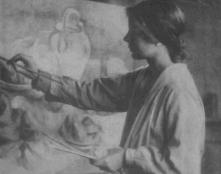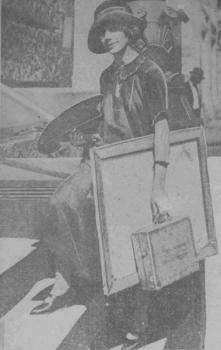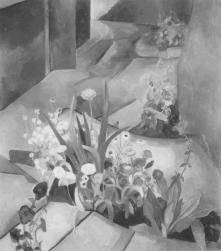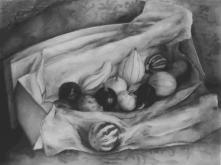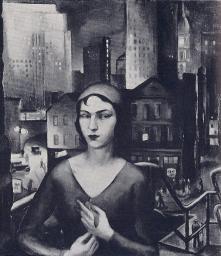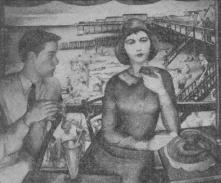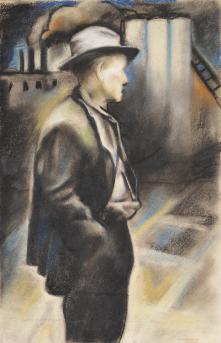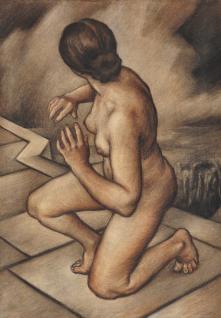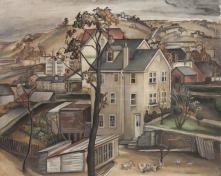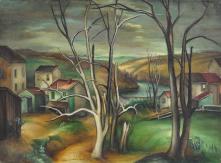Article
GRACE GEMBERLING THORPE KEAST: Sanely Modern
- Date:
- September, 2011
- Author:
To view this article with images and a catalog of available work, please download the PDF below or email us to request a printed catalog.
Few women painters enjoyed the enthusiastic praise Grace Thorpe Gemberling experienced early in her career. Noted for her exceptional handling of color and spacing within her compositions, she contributed greatly towards the acceptance of the modern aesthetic in the Philadelphia region. Born in Bala Cynwyd, PA, in 1903, Grace had the opportunity to witness both the continued growth of Philadelphia and the culture it provided, while being rooted in an agricultural environment that came from her time at the Gemberling farm in Selinsgrove, PA.
The Gemberlings encouraged both Grace and her sister Josephine to embrace the arts. While Josephine became an accomplished musician, Grace gravitated to acting and painting. It became evident as she completed her education at Friends Central School in Philadelphia that Grace’s passion was for art and she enrolled in the Pennsylvania Academy of Fine Arts in 1920 where she studied with Daniel Garber (1880-1958), Hugh H. Breckenridge (1870-1937) and Arthur B. Carles (1882-1952) among others.
It was at the Academy that Grace quickly distinguished herself among her peers. In the time she attended the school, she was twice awarded the coveted Cresson Travelling Scholarship to study in Europe and won a Gold Medal for her “Landscape”. Later the Academy would award her the Mary Smith Prize for Best Prize for a Philadelphia Woman for “Rocks & Flowers” in 1930, award her the Lambert Purchase Prize for her composition “Lilies” in 1936 and honor her with the Fellowship Prize for her composition “Gourds” in 1940. The National Association of Women Painters and Sculptors would award her the Oliver Beck Figure Composition Prize in 1933 for “Amusement Park”.
In addition to her education at the Pennsylvania Academy of Fine Arts, Grace also spent time studying with Hugh H. Breckenridge at his school in Gloucester. Breckenridge’s influence on Grace is evident on several of her earlier works including “Still Life” and a charming portrait of Professor Otakar Sevcik (1852-1936). Each of these works display confident brush work and vibrant color often associated with Breckenridge’s palette. Hugh Breckenridge himself said, “she was the best woman painter I ever taught”. As it was noted in the Philadelphia Recent in 1929:
"Color, the intensified rainbow gamut, so characteristic of Hugh H. Breckenridge and his school may be sensed as a background for much of the theory of application, and achieves its most complete expressions in Grace Gemberling’s well-patterned, well-painted large still-life canvas. Pure color is on every hand and there is a marked tendency to avoid the conventional and commonplace. The result is highly entertaining and at times very pleasing.”
As Grace’s career progressed, her work began to find it’s own voice. Quickly, she became popular with the art press for her ability to make the successful transition to “modern” painting. Characterized as a modernist, Grace’s work displayed daring use of color and space, but did so in a way that was “sanely modern”.
Her work, like Hobson Pittman’s (1899-1972) regarded the importance of conveying a mood in addition to proper compositional techniques. Pittman, an artist and instructor with the Pennsylvania Academy of Fine Arts, regarded Gemberling as “the finest woman painter in Philadelphia during the 20s and 30s.” Other artists shared a style similar to Gemberling including: Nancy Maybin Ferguson (1872-1978), Andrew Michael Dasburg (1887-1979), Carl Lindborg (1903-1994), Robert Miller (1905-1966), Leon Kroll (1884-1974) and others showed a leaning towards subtle abstract compositions and bold colors, but often done in way that emphasizes mood. Gemberling characterized it best in an interview with the Main Line Daily Times in 1933,“I paint to express some personal reaction and I aim toward something deeper than the superficial. I try to appeal not only to the emotional through color, but to the intellectual through design and subject.”
Gemberling’s use of color, design and form in her compositions is a constant theme in the evaluation of her work during this period. In an article entitled “Fresh Paint” for the Philadelphia Art News in esign and form in her compositions is a constant theme in the evaluation of her work during this period. In an article entitled “Fresh Paint” for the Philadelphia Art News in 1938, the writer identifies this ongoing theme with clarity in the statement below:
“Grace Thorpe Gemberling has a little secret of her own when she prepares her colors. We don’t know what it is, but we have felt its effect – the undeniable stamp of an artist’s color personality, as witness her canvases now to be seen at the Women’s University Club.
Color personality, incidentally, occurs none too frequently. When it does, monotony is often its train-bearer. Fortunately, no such thing can be said in this case, and we have ample reason to believe that it shall not in the future.
As personal as are the creations of Grace Gemberling, there is extraordinary variety in her canvasses. The artist’s delineation of well-worn houses is unique as her interpretation of them in color, and there is nothing we like more than the simple but fruitful wedding of line and color mass. Control of detail is, in this case, an additional gift. Canvases may be flooded with subsidiary graphic or pigmental themes, but there is never confusion. Grace Gemberling is one of Philadelphia’s most promising painters.”
Many of Gemberling’s works explore the tension between control and expansion. Ever reaching, Gemberling continually strived to push her subjects and expression modern, while respecting her knowledge of space and form within a composition. The results could be startling. Figures in her paintings seemed to often be in a dreamlike state teetering on indifference. The women in particular appear confident and unimpressed with the observations of others. Could it be a sub-conscious exposition of Gemberling’s own feelings towards those who regularly critiqued her? Anyone who knew Gemberling described her as happy, charming and engaging. She was articulate and a well entrenched member of Philadelphia society. Yet art extracts something deeper. However content Gemberling may have been in her social life, she was striving to say something substantial with her paintings.
Observations of her figurative work invited much discussion regardless of her intentions. Perhaps the best known was her composition entitled, “Holiday”. Exhibited at the North Shore Arts Exhibit at Gloucester in 1933, Holiday had embodied many of the compositional elements often characterizing Gemberling’s work.
“But it would be quite within reason to argue that Grace Thorp Gemberling in “Holiday” contrives the show’s high-water mark. How cunningly in her pallid, gangrenous color she diagnoses beach sickness! Hot dogs and ice cream cones, peanuts and pop here collaborate in the fabrication of an epitaph that is Euclidian in the relentlessness of its logic. Miss Gemberling has, however, done more than just dramatize a mood. Her picture is finely organized and, in its spare form and color relationships, builds up a design that transcends subject…” Edward Alden Jewell, New York Times, 1932.
Where Jewell was struck by a perceived disgust with American leisure, others were drawn in by the psychological implications of the figures in the composition.
“Grace Thorpe Gemberling’s rather curious, but entirely fascinating ‘Holiday’, a boy and his girl at the beach, contains much to ensnare the introspective, for while its intention seems plain enough, there is much more here than meets the eye.” Philadelphia Inquirer, 1932.
The woman figure used in “Holiday” appears to be in “Night Lights” and “Ten Cent Coffee”. Each of these paintings received considerable notice in their exhibitions and each of them convey the figure’s beauty and indifference creating an engaging duality.
What Gemberling did not say in a stare she could project with posture and subject. In “Unemployed” we see the manifestation of a common scene in American society during the 1930s. Here we see a steel executive with slumped shoulders looking back on the plant where he presumably worked. You can feel the resignation in his posture even if you can’t capture it in his eyes. This timeless image would resonate today with the many professionals in America struggling to redefine a career upon being laid-off.
Where the executive gazes with resignation in a passive gesture, body language is more pronounced in the nude sketch made around the same time. Here the woman figure appears in a defensive position awaiting a more dire outcome.Where the figure often broadcasts the mood in the eyes and posture, Gemberling’s landscapes found equal poignancy in their use of light. Sunny days and care-free living are not Gemberling’s stock and trade. Instead, her landscapes take on an eerie quality. Here landscapes took on a Regionalist quality popular during the 1930s. Artists like Thomas Hart Benton (1889-1975) and Louis Lozowick (1892-1973) expressed everyday scenes in both urban and pastoral settings. In this regard, Gemberling also looked to highlight these scenes with her own unique lense. A vibrant color palette combined with clouds and the hint of sun are often used to create landscapes that are more realistic than the sunny days pursued by so many collectors. Instead Gemberling used this effect to emphasize beauty with lingering foreboding. You could argue that many of the figures in her paintings present a similar message (as illustrated in the previously mentioned nude).
What is evident in Gemberlings landscapes is a willingness to present these contrasting elements as shown in the untitled composition (Figure 10). Here we see a family farming before the storm. Instead of facing the viewer in this composition, each of the figures are busying themselves in preparation for it.
While Gemberling’s light effect can be accomplished through transitions of weather, she would often employ a more ethereal mood. This other worldly expression of otherwise mundane views creates compelling land and cityscapes that can leave the viewer with the impression that the composition has a personality, a soul.
“Psychology is also involved, it would seem, in yet another trio, different in visual content, yet bound together by a somewhat grim cincture of mystery and even terror. These are “Victorian Ruins”, “Peabody Hall” and “The Store”. There is something here, beneath the painted similitude of time-worn stone or brick, the ugliness of certain types of architecture, which makes a spectator shrink a trifle as if he were a child again and had to pass a country graveyard at night without the consoling grip of an accompanying hand. There are ways of creating such almost macabre impressions and Miss Gemberling knows them.”
C. H. Bonte, Philadelphia Inquirer, 1935.One of the more eerie elements of many of her landscapes are her trees. Like wispy ghouls shifting across the composition, her trees seem to drift through the painting as vibrant landscapes clash with sullen skies. This untitled landscape provides an excellent example of this formula.
Painted in early Spring, a path runs through the edge of a town along the river. In the foreground those wispy trees flow through the center of the composition. Notice the bright colors in the homes and how they contrast with the cloudy skies above. This landscape is quintessentially handled in the unique Gemberling manner.
This expression of color was noted in a letter composed by the Friends Central School upon the acquisition of her painting, “Pennsylvania Landscape”,
“Her painting is solidly realized and supported by a strong and individual color sense. In this canvas we do not find a literal transcription but a personal interpretation of a thing seen and experienced. This certainly is part of the essence of true art. There are none of the tricks of the camera in Miss Gemberling’s work but an honest and sincere grasp of the essential elements in nature which the true artist is eager to discover.”
What keeps coming through is Gemberling’s distinctive interpretative style. Like any great artist, her goal was to express the feeling of the painting, not just a realistic depiction. Her voice comes through regardless of the style of painting she would execute. Still-lifes, landscapes, cityscapes and figures are all draped in Gemberling’s distinctive mood: ethereal, bold and engaged.
The Philadelphia art circles being what they were in the 1930s and 40s, Gemberling made the acquaintance of a recently widowed W. Morton R. Keast (1888-1973). Keast, a prominent architect in Philadelphia responsible for the design of the Franklin Institute among other important buildings in the Philadelphia area, was also an active art supporter and was previously married to Suzette Schultz Keast (1892-1932) who died at the young age of 40. Suzette Keast was a member of the “Philadelphia Ten” group of exhibiting women painters and a well-respected artist in the Philadelphia community. Morton Keast ultimately married Grace Gemberling and they settled into Philadelphia society.
During what appears to have been a happy period of Gemberling’s life, she took time to continue to teach children and aspiring artists from her home studio (including well-respected artist Jane Piper (1916-1991), throughout the next 50 years. Although Gemberling did not actively exhibit much during this time, her love of the arts was ever present. She stayed active in art circles throughout the remainder of her life and even enjoyed a renaissance of her work in the 1990s thanks to the encouragement and enthusiasm of her manager Boris Wainio. Representing Gemberling, Mr. Wainio successfully put together a retrospective of her work in 1994 at the Rockport Art Association where many of her works were well-received and purchased (including one by the Association itself). Grace Thorpe Gemberling Keast died in 1997. She never had children, but is remembered by Donald Cochran, her nephew.
Grace Thorpe Gemberling (Keast) was not a prolific artist. The bulk of her work was produced within a 20-year time frame before she married Morton Keast. During that brief period in her life, Gemberling produced some of the most highly regarded works by a Philadelphia painter and enjoyed both critical and financial success. Her unique approach to make a painting her own through dream-like compositions makes her a significant influence on the modern aesthetic not only in Philadelphia, but throughout the United States.


